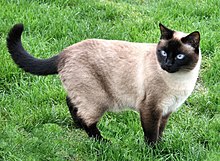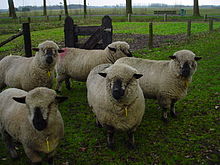Point coloration

Point colorationisanimal coatcoloration with a pale body and relatively darker extremities, i.e. the face, ears, feet, tail, and (in males)scrotum.It is most recognized as the coloration ofSiameseand related breeds ofcat,but can be found indogs,rabbits,rats,sheep,guinea pigsandhorsesas well.
In cats[edit]

Point coloration in cats originated in theSiameseand closely related Asian breeds, and is found in many Western-developed modern breeds. It is a form of partialalbinismresulting from amutationthat affectstyrosinase,an enzyme involved withmelaninproduction. The mutated enzyme isthermolabile;it fails to work at normal body temperatures, but becomes active in cooler areas of the skin.[1]As a result, dark pigment is limited to the coldest areas of the body, that is, the extremities. Pointedkittensare born white, since the womb is uniformly warm. As the kitten ages, the cooler areas darken while warmer areas remain cream to white in color. Points are not limited to solid colors or dark colors. It is possible to have a red (orange color) or fawn (pale warm gray) point. It is also possible to have atortoiseshellortabbypoint. A cat (of any breed) with this coloration is often called acolorpoint catto distinguish it from others.
As the expression of the gene responsible for the pointed pattern is regulated by temperature, pointed cats who live in cooler environments often show increased darkening of their fur relative to cats who live in warmer climates, sometimes even developing large dark areas along their sides.
Because of the pigment restriction caused by the temperature sensitive tyrosinase, pointed cats' eyes are always shades of blue because the blue layer in the eye common to all cats is not covered by another color. The back of the eye also lacks pigment, giving colorpoint cats' pupils an eerie red and silver reflection in the dark, unlike a normally pigmented cat's shining silver-green or -blue.
Thepoint geneallele is at the Clocus,where purealbinismis also carried, and is written ascs.Point is recessive, so two copies ofcs,one from each parent, are needed for points to be expressed. Also carried on the C locus is the gene for thesepiapattern, which allele is represented bycb.This is the darkest of all of the pigment restricting patterns—pigment is only paled at the warmest point in the body: the abdomen. Sepia cats have amber-yellow to green eyes. When a cat carries the genescsandcb,the intermediateminkpattern is formed, in which the pigment distribution is between sepia and point. The eye color of mink cats is on the blue-green spectrum (aquamarine).
- Comparison of different black (seal, sable) colourpoint cats
-
Black pointSiamese
-
Black minkTonkinese
-
Black sepiaBurmese
-
Blacktortoiseshellpoint cat
Thelynx pointpattern is formed by mating a colorpoint cat with atabby cat(or breeding cats that already possess the lynx point pattern). It is characterized by a mixture of the darkening (reduced) of point coloration with distinct tabby striping on the head, tail, and legs, and an otherwise uniform and comparatively pale body. It is an accepted pattern in some cat registries, but not others, for particular breeds (mostly Siamese-related).
Point coloration is inherent to the Siamese breed and some other closely related breeds but with most other breeds the colorpoints (including lynx) were brought into some breed lines long after their establishment, but there are exceptions. For example, lynx point was a feature of some of thefoundation stockof theSiberian,now called theNeva Masquerade.[2]
Cat breeds[edit]
In dogs[edit]
This sectionneeds expansion.You can help byadding to it.(March 2021) |
Tan points on dogs includes point coloration on a black or dark base coat with tan cheek spots, eyebrows, feet, forelegs and tail vent.[3]Typical tan point breeds includeDobermannandRottweiler.[4]
Rarely, dogs may also have a point coloration similar to that of Siamese cats.[5]
In horses[edit]

In horses, point coloration is most often produced by the action of theagoutigene. It acts on theextension gene,when present, to suppress black color to all but the extremities of the horse; the legs, mane, tail and tips of the ears. If the extension gene is not present, the effect of agouti is not visible, as there is no black color present to suppress. Points are most typically seen on abay-colored horse, which has a black mane, tail, legs, and ear tips while the body and head will show the underlyingchestnutor "red" base color.
Other geneswhite markingsmay affect a horse's coat color in addition to agouti, and if present, can further alter or suppress black hair color and may mask any point coloration. In particular,Grayhorses are born dark and lighten with age; if born bay, they will eventually lose point coloration as the body hair silvers with age, though often the points are the slowest areas of the body to go gray.
Point coloration may also be visible on horses with otherdilution genesthat act upon a bay base coat. These include:
- Thecream gene,anincomplete dominant,that whenheterozygousproducesBuckskin.When homozygous, even point coloration is mostly suppressed, the color is calledperlino,and some individuals may have slightly redder hair at the traditional point coloration locations.
- TheChampagne gene,which on a bay base produces Amber Champagne.
A dilution gene that produces what looks like point coloration, but from a completely different genetic mechanism is thedominantDun gene,which dilutes the color of the body coat but not the points, includingprimitive markings—a dorsal stripe down the back and, less often, horizontal striping on the upper legs. On a bay base coat the dun gene leaves black points, producing a Bay Dun or "Zebra" Dun. But the gene also leaves the points dark when it appears with other base colors. These include the “blue dun” orgrullo,which has a black base coat, and the red dun, which has a chestnut base coat.
Similarly, darker coloration at the points is also preserved in horses with theroan gene,a patterning gene, producing a body coat of mingled white and dark hairs, but leaving the points the darker base color in all horses, not just those carrying agouti.
Most other genes that produce spotting patterns orwhite markingsallow point coloration produced by agouti to show except where masked by white depigmentation. There are not always separate names for a pattern over a bay base coat, but one exception is theBay pinto,sometimes called”tricoloured”.
-
White markings may partially or completely mask point coloration in horses
-
The dun gene leaves the points darker on all base coat colors, not just when agouti is present
-
The roan pattern allows point coloration to show on the head as well as traditional point locations
In rabbits and rodents[edit]

All pointed white rabbits of true breeding have red eyes.[6]The pointed white rabbit is created with the ch gene.[7]Its presentation is typified in theHimalayan rabbitbreed (the first rabbit breed with a pointed white coat) and in theCalifornianbreed.
Rabbit coat colors[edit]
Some rabbits that appear to be pointed white lack the red eyes, which indicates they are of different breeding. The following such coat colors are examples of those created, not with the ch gene, but with the cchl, cchd, or cchm gene in conjunction with the e gene:[citation needed]
- Blue point
- Chocolate point
- Lilac point
- Pearl
- Sable point
- Sallander
- Seal point
- Siamese
No pointed white rabbit can produce orange pigment; therefore, the points are always either black, blue, chocolate, or lilac.[citation needed]The resulting point coloration is sometimes in conjunction with a coat pattern, such as: white agouti, marten, broken, Vienna, or harlequin. (Such coats may not be recognized for showing.)
Rabbit breeds[edit]
Breeds of rabbitthat include varieties with point coloration include:[8][9]
In fancy (domestic) rats[edit]
The C - Albino locus gene causes dilution of yellow and black coloration, causing Himalayan or Siamese markings depending on the allele is affected.
Point colors in rats include:
- Sepia
- Seal Point
- Blue Point[10]
In guinea pigs[edit]
There is only one type of guinea pig with a pointed coat. It is called theHimalayan,has either Black (a very dark brown) or Chocolate, tipped on the Ears, Nose, and Feet.
In sheep[edit]

Some breeds of sheep exhibit point coloration.
Sheep breeds[edit]
References[edit]
- ^D. L. Imes; et al. (April 2006)."Albinism in the domestic cat (Felis catus) is associated with atyrosinase(TYR) mutation ".Animal Genetics.37(2): 175–8.doi:10.1111/j.1365-2052.2005.01409.x.PMC1464423.PMID16573534.
- ^TICA."Siberian Introduction"(PDF).
- ^"GLOSSARY OF TERMS Used in Relation to Dog Coat Colours and Patterns".www.lowchensaustralia.com.Chinaroad Lowchens of Australia.Retrieved11 December2018.
- ^"Dog Coat Colour Genetics".www.doggenetics.co.uk.Retrieved11 December2018.
- ^Bychkova, Elina; Viktorovskaya, Olga; Filippova, Elizaveta; Eliseeva, Zhanna; Barabanova, Larisa; Sotskaya, Maria; Markov, Anton (2021). "Identification of a candidate genetic variant for the Himalayan color pattern in dogs".Gene.769:145212.doi:10.1016/j.gene.2020.145212.PMID33039541.S2CID222302410.
- ^"Himalayan rabbit",Wikipedia,2020-01-14,retrieved2020-09-02
- ^"Rabbit Color Genetics: Self Chinchilla Explained – Rabbit Smarties: Creative Resources for Rabbit Keepers".19 July 2011.Retrieved2020-09-02.
- ^Standard of Perfection 2016-2020.American Rabbit Breeders Association. 2015.ASINB018GVBJK4.
- ^"Breed Standards 2016-2020"(PDF).British Rabbit Council.Archived fromthe original(PDF)on 21 January 2018.Retrieved11 February2018.
- ^"AFRMA - Rat Genetics, part 1".









